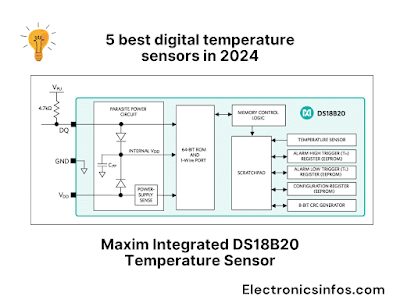What are Digital Temperature sensors?
Types of Temperature Sensor
- Digital Thermocouples
- Digital Thermistors
- Digital Resistance Temperature Detectors (RTDs)
- Digital Infrared (IR) Temperature Sensors
- Digital Semiconductor Temperature Sensors
- Digital One-Wire Temperature Sensor
Application of Temperature Sensor
- Temperature sensors are used in material fabrication and product quality.
- Temperature sensors help regulate heating, ventilation, and air conditioning systems.
- Sensors monitor engine temperature to optimize fuel injection, ignition timing, and cooling systems.
- They are used in vehicle climate control systems.
- Temperature sensors are used in medical devices to monitor patient body temperature.
- Temperature sensors protect electronic components from overheating by regulating cooling systems.
- They are used in ovens, refrigerators, and air conditioners to maintain desired temperature settings.
- Temperature sensors measure atmospheric conditions.
5 best digital temperature sensors List
- Texas Instruments TMP117
- Maxim Integrated DS18B20
- Analog Devices ADT7410
- STMicroelectronics STTS751
- Honeywell HIH6130
Texas Instruments TMP117 Temperature Sensor
The TMP117 is a high-accuracy digital temperature sensor with an accuracy of ±0.1°C. It offers a wide temperature measurement range (-40°C to +125°C). It operates with low power consumption.
key features of the TMP117
- High Accuracy
- Low Power Consumption
- Wide Temperature Range
- Digital Interface
- Integrated Features
- Small Form Factor
- Low Output Noise
Maxim Integrated DS18B20 Temperature Sensor
The DS18B20 is a widely used digital temperature sensor with a unique 1-wire interface. This feature allows multiple sensors to be connected in parallel using just one data line. It provides high-precision temperature measurements with a typical accuracy of ±0.5°C.it temperature range of -55°C to +125°C. The DS18B20 is known for its simplicity and ease of integration.
key features of the DS18B20
- Unique 1-Wire Interface
- Wide Temperature Range
- Programmable Resolution
- Parasitic Power Mode
- High Accuracy
- Integrated Temperature Conversion
- Programmable Alarm Function
Analog devices ADT7410 Temperature Sensor
The ADT7410 is a digital temperature sensor with a resolution of up to 16 bits Its accuracy of ±0.5°C. It offers a wide temperature measurement range (-40°C to +125°C).it is a high-speed, 2-wire serial interface (I2C-compatible). The sensor includes a programmable interrupt function for temperature threshold monitoring.
key features of the ADT7410
- Wide Temperature Range
- I2C Interface
- High Resolution
- Low Power Consumption
- Configurable Alert Function
- Small Form Factor
- High Accuracy
- High Noise Immunity
STMicroelectronics STTS751 Temperature Sensor
The STTS751 is a digital temperature sensor with an accuracy of ±0.5°C. It operates over a wide temperature range (-55°C to +125°C). The STTS751 includes programmable features such as temperature threshold detection and user-defined conversion rates.
key features of the STTS751
- High Accuracy
- Wide Temperature Range
- I2C Interface
- Configurable Conversion Rate
- Low Power Consumption
- Programmable Alert Function
- Small Form Factor
- Low Noise
Honeywell HIH6130 Temperature Sensor
The Honeywell HIH6130 is a digital humidity and temperature sensor that provides accurate and reliable measurements.
key features of the HIH6130
- Combined Humidity and Temperature Measurement
- High Accuracy
- Wide Operating Range
- Integrated Digital Interface
- Low Power Consumption
- Calibration and Digital Compensation
- Small Form Factor
- High Reliability
Applications of Digital temperature sensors
- Digital temperature sensors are used in heating, ventilation, and air conditioning systems
- They are utilized in consumer electronics such as smartphones, laptops and tablets.
- Digital temperature sensors are employed in refrigerators, freezers, cold storage facilities, and food processing equipment in the food industry.
- Researchers use digital temperature sensors in laboratories and scientific experiments to measure temperature variations for thermal analysis.
- In agriculture, digital temperature sensors are used in greenhouse climate control and soil temperature monitoring.
- digital temperature sensors are used in cold chain logistics monitoring the temperatures of goods.
- Digital temperature sensors are used in data centres to monitor server room temperatures.
Conclusion
Frequently Asked Questions – FAQs
What is a digital temperature sensor?
How do digital temperature sensors work?
What are the advantages of digital temperature sensors over analogue sensors?
- Digital sensors generally provide more accurate readings.
- They are easier to interface with microcontrollers and digital systems.
- Digital signals are less noise and signal degradation over long distances.
- Digital sensors can include built-in processing capabilities for more advanced functionality.
What are the common communication protocols used by digital temperature sensors?
- I2C: Inter-Integrated Circuit, a common two-wire communication protocol.
- SPI: Serial Peripheral Interface, a four-wire communication protocol.
- UART: Universal Asynchronous Receiver-Transmitter, used for serial communication.
- 1-Wire: A single-wire communication protocol often used for simple sensor networks.
What is the typical accuracy of digital temperature sensors?
What is the operating temperature range for digital temperature sensors?
What are some common applications of digital temperature sensors?
- Consumer Electronics
- Medical Devices
- Automotive
- HVAC Systems
- Environmental Monitoring
What are some popular digital temperature sensors?
- DS18B20
- LM75
- TMP36
- DHT22
Related Posts







.png)



0 Comments
please do not insert spam links